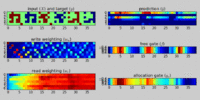Biography:Alex Graves (computer scientist)
Alex Graves | |
|---|---|
| Education |
|
| Known for | |
| Scientific career | |
| Institutions | DeepMind |
Alex Graves is a computer scientist. Before working as a research scientist at DeepMind, he earned a BSc in Theoretical Physics from the University of Edinburgh and a PhD in artificial intelligence under Jürgen Schmidhuber at IDSIA.[1] He was also a postdoc under Schmidhuber at the Technical University of Munich and under Geoffrey Hinton[2] at the University of Toronto.
At IDSIA, Graves trained long short-term memory neural networks by a novel method called connectionist temporal classification (CTC).[3] This method outperformed traditional speech recognition models in certain applications.[4] In 2009, his CTC-trained LSTM was the first recurrent neural network to win pattern recognition contests, winning several competitions in connected handwriting recognition.[5][6] Google uses CTC-trained LSTM for speech recognition on the smartphone.[7][8]
Graves is also the creator of neural Turing machines[9] and the closely related differentiable neural computer.[10][11] In 2023, he published the paper Bayesian Flow Networks.[12]
References
- ↑ "Alex Graves". http://www.cifar.ca/alex-graves.
- ↑ "Marginally Interesting: What is going on with DeepMind and Google?". 28 January 2014. http://blog.mikiobraun.de/2014/01/what-deepmind-google.html. Retrieved May 17, 2016.
- ↑ Alex Graves, Santiago Fernandez, Faustino Gomez, and Jürgen Schmidhuber (2006). Connectionist temporal classification: Labelling unsegmented sequence data with recurrent neural nets. Proceedings of ICML’06, pp. 369–376.
- ↑ Santiago Fernandez, Alex Graves, and Jürgen Schmidhuber (2007). An application of recurrent neural networks to discriminative keyword spotting. Proceedings of ICANN (2), pp. 220–229.
- ↑ Graves, Alex; and Schmidhuber, Jürgen; Offline Handwriting Recognition with Multidimensional Recurrent Neural Networks, in Bengio, Yoshua; Schuurmans, Dale; Lafferty, John; Williams, Chris K. I.; and Culotta, Aron (eds.), Advances in Neural Information Processing Systems 22 (NIPS'22), December 7th–10th, 2009, Vancouver, BC, Neural Information Processing Systems (NIPS) Foundation, 2009, pp. 545–552
- ↑ A. Graves, M. Liwicki, S. Fernandez, R. Bertolami, H. Bunke, J. Schmidhuber. A Novel Connectionist System for Improved Unconstrained Handwriting Recognition. IEEE Transactions on Pattern Analysis and Machine Intelligence, vol. 31, no. 5, 2009.
- ↑ Google Research Blog. The neural networks behind Google Voice transcription. August 11, 2015. By Françoise Beaufays http://googleresearch.blogspot.co.at/2015/08/the-neural-networks-behind-google-voice.html
- ↑ Google Research Blog. Google voice search: faster and more accurate. September 24, 2015. By Haşim Sak, Andrew Senior, Kanishka Rao, Françoise Beaufays and Johan Schalkwyk – Google Speech Team http://googleresearch.blogspot.co.uk/2015/09/google-voice-search-faster-and-more.html
- ↑ "Google's Secretive DeepMind Startup Unveils a "Neural Turing Machine"". https://www.technologyreview.com/s/532156/googles-secretive-deepmind-startup-unveils-a-neural-turing-machine/. Retrieved May 17, 2016.
- ↑ Graves, Alex; Wayne, Greg; Reynolds, Malcolm; Harley, Tim; Danihelka, Ivo; Grabska-Barwińska, Agnieszka; Colmenarejo, Sergio Gómez; Grefenstette, Edward et al. (2016-10-12). "Hybrid computing using a neural network with dynamic external memory" (in en). Nature 538 (7626): 471–476. doi:10.1038/nature20101. ISSN 1476-4687. PMID 27732574. Bibcode: 2016Natur.538..471G. https://ora.ox.ac.uk/objects/uuid:dd8473bd-2d70-424d-881b-86d9c9c66b51.
- ↑ "Differentiable neural computers | DeepMind". https://deepmind.com/blog/differentiable-neural-computers/.
- ↑ , Wikidata Q121625910
 |


